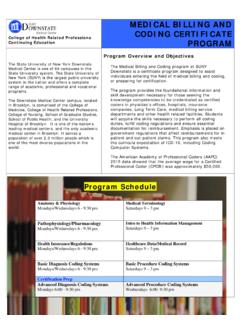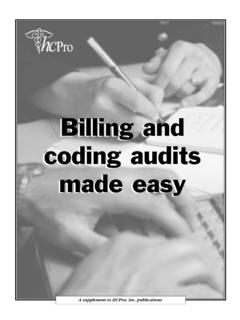Transcription of The Hospital Billing Process - Coursewareobjects.com
1 Ch 2/6/06 5:49 PM Page 131. 131 Section One: Section Title Chapter 00: Chapter Title 131. Chapter 5. The Hospital Billing Process T he purpose of this chapter is to provide an overview of the Hospital Billing Process . The Billing Process includes submitting charges to third-party payers and patients, posting patient transactions, and following-up on outstanding accounts. As discussed in the previous chapter, information collected during the patient visit is utilized to complete the tasks required to bill for services rendered. A review of the purpose of the Billing Process will Outline provide an understanding of how vital Billing functions are PURPOSE OF THE Billing Process . for the Hospital to maintain a sound financial base. PAYER GUIDELINES. The role of Hospital Billing and coding professionals is Participating Provider Agreements complicated because of the ever-changing health insurance Claim Forms environment and variations in payer guidelines. It is Clean Claim essential for Billing and coding professionals to understand Reimbursement Methods payer guidelines in order to ensure that proper reimburse- Reimbursement Methods by Service Category ment is obtained and to be compliant with payer guidelines.
2 Reimbursement Methods by Payer Category A review of several elements of the participating provider agreement payer contract will illustrate how payer guide- CHARGE DESCRIPTION MASTER (CDM). lines vary and the significant impact they have on the Billing Services and Items Billed by the Hospital Process . A discussion of how charges are captured, coding Hospital Categories of Services and Items systems, and claim forms will provide a basis for an under- Content of the Charge Description Master (CDM). standing of the Billing Process . The chapter will close with Chargemaster Maintenance an overview on the Hospital Billing Process from patient coding SYSTEMS. admission to collections. Many of the concepts presented in Procedure coding Systems this chapter are described briefly. More detailed discussion Diagnosis coding Systems will be provided in later chapters. coding Systems for Outpatient and Inpatient UNIVERSALLY ACCEPTED CLAIM FORMS. Chapter Objectives CMS-1500. Define terms, phrases, abbreviations, and acronyms CMS-1450 (UB-92).
3 Related to the Hospital Billing and claims Process . Detailed Itemized Statement Demonstrate an understanding of the Billing Process Manual versus Electronic Claim Submission and its purpose. THE Hospital Billing Process . Discuss the relationship among participating provider Patient Admission and Registration agreements, claim forms, reimbursement methods, and the Patient Care Order Entry Billing Process . Charge Capture Explain the significance of submitting a clean claim. Chart Review and coding Demonstrate understanding of the variations in claim Charge Submission requirements by payer type and type of service Reimbursement Explain the purpose of the chargemaster and its Accounts Receivable (A/R) Management relationship to Billing . List and explain data elements in the chargemaster and discuss maintenance of the chargemaster. Provide an overview of categories of services and items billed by the Hospital . Differentiate between coding systems utilized for outpatient services versus those used for inpatient services.
4 Discuss the purpose of the detailed itemized statement. Briefly discuss the purpose of a claim form and provide a brief outline of information recorded on a claim form. Demonstrate an understanding of all elements and phases in the Hospital Billing Process . Explain the significance of A/R management. 131. Discuss claims that do not meet clean claim status. Ch 2/6/06 5:49 PM Page 132. 132 Section Two: Billing and coding Process Key Terms Accounts receivable (A/R) management Participating provider agreement Ambulatory payment classifications (APC) Patient invoice Ambulatory surgery Patient statement Batch Per diem Billing Process Percentage of accrued charges Capitation Professional charges Case mix Prospective Payment System (PPS). Case rate Reimbursement Charge Description Master (CDM) Relative value scale (RVS). Claims Process Resource-based relative value scale (RBRVS). Clean claim Revenue code Clearinghouse Third-party payer CMS-1450 (UB-92) Usual, customary, and reasonable CMS-1500 UB-92.
5 Collections Contract rate Acronyms and Abbreviations Detailed itemized statement APC Ambulatory payment classification Diagnosis Related Group (DRG) CMS- Centers for Medicare and Medicaid Services Electronic data interchange (EDI) CDM- Charge Description Master Electronic media claim (EMC) DRG- Diagnosis Related Group Encoder EDI- electronic data interchange Facility charges EMC- electronic media claim Fee-for-service FL- form locator Fee schedule HCPCS- Health Care Common Procedure coding Flat rate System Form locator (FL) IPPS- Inpatient Prospective Payment System GROUPER NUBC- National Uniform Billing Committee Health Care Common Procedure coding System OPPS- Outpatient Prospective Payment System (HCPCS) (OPPS). Inpatient Prospective Payment System (IPPS) RBRVS- resource-based relative value scale Outpatient Prospective Payment System (OPPS) RVS- Relative value scale PURPOSE OF THE Billing Process reimbursement. It includes patient registration, posting The purpose of the Hospital Billing Process is to obtain charges to the patient's account, chart review and reimbursement for services and items rendered by the coding , preparing claim forms and patient invoices or Hospital .
6 Reimbursement is received from patients, statements for charge submission, and monitoring and insurance carriers, and government programs. The follow-up of outstanding accounts. The term claims Hospital Billing Process begins when a patient arrives at Process refers to the portion of Billing that involves the Hospital for diagnosis and treatment of an injury, preparing claims for submission to payers. An extension illness, disease, or condition. The patient's demographic of the Billing Process is collections, also known as A/R. and insurance information is obtained and registered in management, which involves monitoring accounts that the Hospital 's information system. Physician's orders or are outstanding and pursuing collection of those a requisition outlines the patient care services required. balances from patients and third-party payers. The Patient care services and items provided during the Hospital Billing Process is illustrated in Figure 5-1. patient's stay are recorded on the patient's account.
7 The complexity of the Hospital Billing Process is a Charges are posted to the patient's account by various result of the health care industry's evolution. The history departments. When the patient leaves the Hospital , all of hospitals explains how medicine changed over the information and charges are prepared for Billing . The years and how hospitals evolved as a result of that Billing Process involves all the functions required to change. It also shows the relationship among advances prepare charges for submission to patients and third- in medicine, Hospital evolution, and rising health care party payers in order for the Hospital to obtain costs. Health insurance and government-funded health Ch 2/6/06 5:49 PM Page 133. Chapter 5: The Hospital Billing Process 133. Admission was enhanced. Contracts between providers and payers (Patient registration) were initiated. The Process of submitting charges became more involved than providing services and collecting a fee from the patient.
8 It now involves authorizations and Patient Care Services certifications, medical record documentation, coding , Rendered participating provider agreements, various payer guide- (Documentation - medical Record). lines, and different reimbursement systems (Figure 5-2). Because of the complexity of this system, Hospital bill- ing and coding professionals are required to have know- Charge Capture (Posting charges to the patient's ledge of all these elements to ensure that appropriate account through the chargemaster reimbursement is obtained and is in compliance with HCPCS codes associated with each item payer guidelines. in the chargemaster). PAYER GUIDELINES. Chart Review/ coding (HIM code procedure and Variations in payer guidelines contribute significantly to diagnosis) the complexity of the Billing Process . Guidelines for the provision of patient care services and claim submission and reimbursement vary from payer to payer. Hospitals Charge Submission are required to comply with all provisions in their (Prepare patient invoices and participating provider agreements.)
9 Compliance with insurance claim forms for submission). these guidelines is a condition for receiving reimburse- ment, and legal consequences may result from non- compliance. A review of some common provisions in a Accounts Receivble (A/R). participating provider agreement will contribute to an Management understanding of the relationship between the agree- (Monitor and follow-up on outstanding ments and the Billing Process . accounts, known as collections). Figure 5-1 The Hospital Billing Process . Begins with Participating Provider Agreements registration during the patient admission Process . The Hospital 's payer mix highlights the various payers that provide coverage to patients seen at the Hospital . care benefit programs were born. Over the years, more Medicare, Medicaid, TRICARE, Blue Cross/Blue Shield, insurance companies and government programs came Worker's Compensation, automobile insurance, and into existence. Regulation of the health care industry various managed care plans are generally part of the BEFORE 1965.
10 Patient requires Doctor assessment health care services and treatment of patient Patient pays TODAY. Government payers Payer guidelines Patient requires Doctor assess- Regulation Regulation health care ment and treat- Participating services ment of patient provider Claim forms Payment Billing agreements coding systems Payer contracts . medical Denials Process Patient Managed necessity Inaccurate Paperwork medical care payers Payment Insurance Record Reimbursement Appeals Commercial payers systems Authorizations, Docu- Figure 5-2 The evolution and Payment approvals, mentation determinations complexity of the Billing Process referrals, etc. coding from 1965 to today. Ch 2/6/06 5:49 PM Page 134. 134 Section Two: Billing and coding Process Participating Provider Agreement This Agreement is entered into by and between Community Hospital , contracting on behalf of itself, ABC. Health Insurance, Inc. and the other entities that are ABC Affiliates (collectively referred to as "ABC") and Community (" Hospital ).






